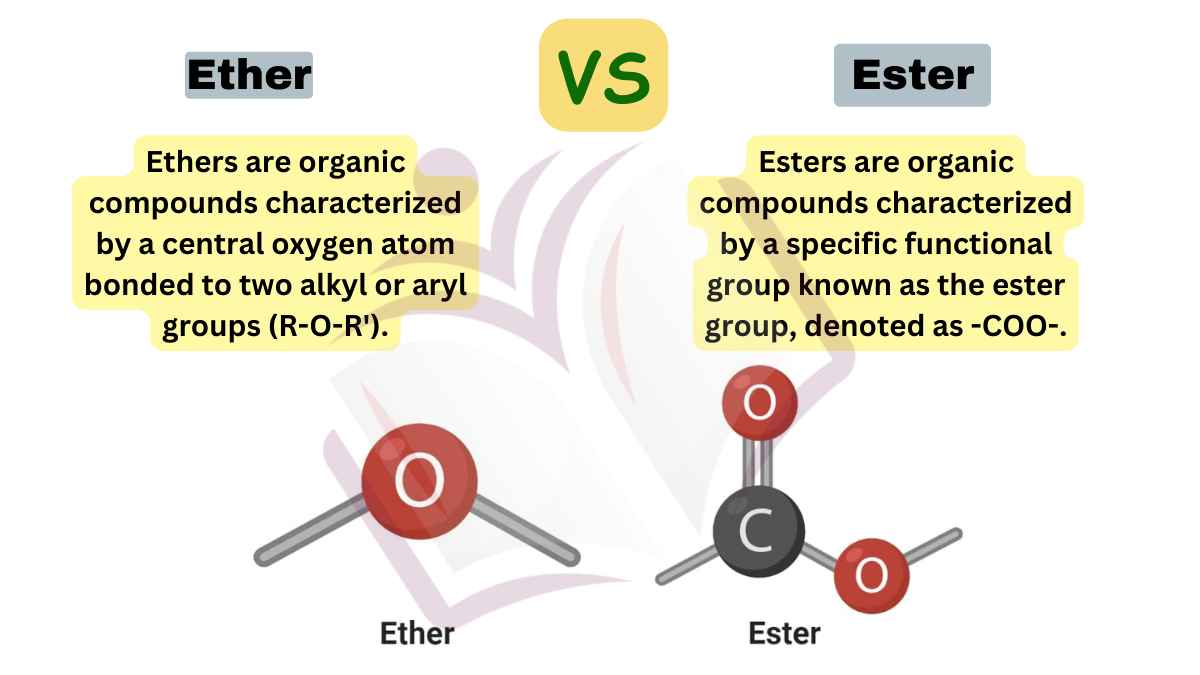The key difference between ether and ester is that ethers have an oxygen atom bonded to two alkyl or aryl groups (R-O-R’), while esters have an oxygen atom between a carbonyl group and an alkyl or aryl group (R-CO-O-R’).

What is Ether?
Ethers are organic compounds characterized by a central oxygen atom bonded to two alkyl or aryl groups (R-O-R’). They possess a unique structural arrangement in which the oxygen atom is surrounded by carbon chains on both sides. Ethers are known for their low reactivity and relatively inert nature, which can be attributed to the absence of acidic or basic functional groups.
They are widely used as solvents due to their ability to dissolve a variety of substances. Ethers can be prepared through Williamson ether synthesis, which involves the reaction of an alkoxide ion with an alkyl halide. While ethers themselves are relatively unreactive, they can undergo cleavage reactions in the presence of strong acids, resulting in the formation of alcohols and alkyl halides.
What is Ester?
Esters are organic compounds characterized by a specific functional group known as the ester group, denoted as -COO-. This group consists of a carbonyl group (C=O) bonded to an oxygen atom (O), which is further linked to an alkyl or aryl group (R). Esters are widely found in nature, contributing to the aroma and flavor of many fruits and flowers.
They are responsible for the scents of essential oils, perfumes, and various fragrant compounds. Esters are commonly formed through the reaction between carboxylic acids and alcohols, known as esterification. They possess diverse chemical and industrial applications, including use as solvents, plasticizers, and intermediates in the production of polymers, pharmaceuticals, and cosmetics. Esters also play crucial roles in biochemistry, being involved in processes like lipid metabolism and cell signaling.
Ether vs Ester
The primary difference between ether and ester is given below:
| Characteristic | Ethers | Esters |
| Functional Group | R-O-R’ (Oxygen between two alkyl groups). | R-CO-O-R’ (Carbonyl group bonded to an alkyl group and an alkoxy group). |
| Naming Pattern | Commonly named by listing the two alkyl groups attached to oxygen. | Named by identifying the alkyl group bonded to the carbonyl carbon and the alkyl group bonded to the oxygen. |
| Odor and Flavor | Often have a relatively neutral odor and are less aromatic. | Frequently possess pleasant fruity or floral odors and flavors. |
| Occurrence in Nature | Common in both natural and synthetic compounds. | Found in natural sources such as fruits, flowers, and essential oils. |
| Biological Significance | Generally less reactive and less involved in biochemical processes. | Essential in various biological processes, including metabolism and signaling. |
| Preparation | Prepared through Williamson ether synthesis or other methods. | Formed by the reaction between a carboxylic acid and an alcohol (esterification). |
| Examples | Diethyl ether, methyl tert-butyl ether (MTBE). | Ethyl acetate, methyl salicylate (oil of wintergreen). |
